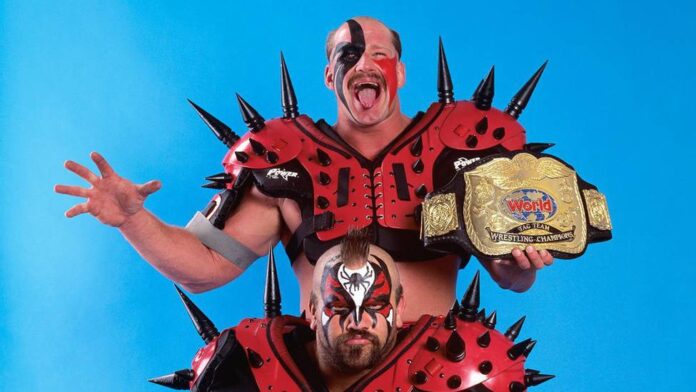Michael Hegstrand aka Road Warrior Hawk shaped the myth of the legendary Legion of Doom at WWE and Co. but lived a life of excess behind the scenes. He died 20 years ago today.
What a rush – oh, what a rush!
For decades, every wrestling fan knew this legendary battle cry, inextricably linked to one of the greatest success stories in show fighting history.
The Road Warriors Hawk and Animal were one of the most popular, intriguing and copied ring duos ever in wrestling. To this day, they are the quintessential tag team for many fans.
Since the 1980s, the two musclemen with the destroyer aura thrilled millions of followers worldwide, and a late WWE comeback in 2003 still caused storms of enthusiasm.
A few months later, on October 19, 2003, however, the myth of the original LOD came to a tragic end: 20 years ago today, Michael Hegstrand aka Road Warrior Hawk passed away at just 46 years old.
Road Warrior Hawk and Animal – a distinctive duo
Born on January 26, 1957 in Saint Paul, Minnesota, Hegstrand came to his fame, which continues to this day, rather by accident: after graduating from high school, he worked various odd jobs, including as a butcher and as a bouncer in a nightclub.
The well-known wrestling trainer Eddie Sharkey discovered the brawny 1.91-meter man there and trained him for wrestling, together with his later partner Joe Laurinaitis and the also famous “Ravishing” Rick Rude, Nikita Koloff and Barry Darsow (Demolition Smash, Repo Man).
Laurinaitis debuted before Hegstrand as “The Road Warrior”, inspired by the 1981 film Mad Max 2, which had this subtitle in the original English.
Later, Laurinaitis and Hegstrand found themselves together under the direction of their longtime manager Paul Ellering, and together they transferred more set pieces from the Mad Max universe to the wrestling ring: the two shaved mohawk haircuts, wrapped themselves in leather gear and dog collars, and made warrior-like face paint their trademarks – later, the famous spiked shoulder pads rounded out the menacing overall image.
With Mad Max look to the myth
With their distinctive look, charisma, and explosive dominant power style, the two became a box office hit.
Hawk and Animal won the tag team titles of all the major leagues of their time. Even before their debut in the former WWF in 1990, their appearances in regional and nationwide leagues such as the Jim Crockett Promotions (precursor to WCW) and the AWA gave the two a reputation like thunder, and they also increased their myth in various promotions in Japan.
With quick and impressive victories, the duo – who triumphantly moved in and out to the metal classic “Iron Man” by Ozzy Osbourne’s band Black Sabbath – was staged as a seemingly indomitable force. The winning formula was often emulated, not least in building the Bill Goldberg phenomenon in the nineties in WCW and later in WWE.
Hegstrand was, all things considered, the more important building block of success: he had the greater charisma and speaking talent, and the more spectacular promotions: He was nicknamed “Hawk” (hawk or falcon) because of the aerial maneuvers, unusual for a man of his size at the time, such as the famous finisher Doomsday Device, in which he ripped the opponent from Animal’s shoulders with a leap from the rope.
Model for many teams in WWE
When they were in WWE, they received tag team gold twice – which didn’t come close to living up to their exceptional status, however, it’s impossible to imagine their legacy without the catchy theme with “Oh what a Rush!” created by Hegstrand that was written all over them there.
If you want to better understand the Road Warriors fascination, however, you should search the online archives for the material away from WWE: The matches against the Steiner Brothers in WCW and in Japan (partly with local hero “Power Warrior” Kensuke Sasaki as the third man), but especially Crockett classics from the eighties, the encounters with the Midnight Express, the duo Arn Anderson and Tully Blanchard and especially the appearances in the “War Games” as part of the cage battles with Ric Flair’s Four Horsemen.
The significance of the Road Warriors was also made especially clear by the multitude of teams that emulated them, some while they themselves were still at their peak. Demolition, WWE’s longtime record-breaking titleholders, were essentially a ripoff of the Road Warriors before the original went to the then-WWF, much like the Powers of Pain or later The Ascension and the Authors of Pain (AOP), accompanied to the ring in WWE initially by LOD journeyman Paul Ellering.
Troubled relationship with Vince McMahon
Despite their popularity, Hawk and Animal didn’t leave quite as much of a mark on WWE as they did elsewhere, in part because their relationship with WWE boss Vince McMahon soured early on.
Before their first move in 1990, Hawk and Animal had a mega-contract with Crockett that had earned them both the then horrendous annual salary of $500,000. When the struggling league could no longer afford that, they moved over to WWE – where McMahon gave no written guarantee but a verbal one that they would make more money with him than before.
The opposite happened – and Hawk in particular was said to be pissed off about it. After SummerSlam 1992 in London, where the two rode in on motorcycles for their match against Money Inc (Ted DiBiase and Bray Wyatt’s father Irwin R. Schyster), Hawk refused to return to America and dumped the League. Animal, who was on his own, ended his career shortly thereafter in the interim.
Embarrassing low point in WWE
First there was a reunion at WCW in early 1996, but after that they could only conditionally continue their golden days, even and especially not when they went to WWE once again and became part of the Attitude Era. Neither a repaint as the futuristic “LOD 2000″ with the now deeply fallen manager Sunny could hide the diminishing luster, nor the connection with the young talent Droz.
At the time, attempts to work a real event into the script went particularly awry: the drug problems from which Hegstrand suffered: the staging of an implied suicide attempt by a meter-deep fall from the “Titan Tron” video screen was the low point.
LOD’s final WWE appearance in May 2003 did the pair more justice despite their advancing age: in an unannounced title match against then tag team champions Rob Van Dam and Kane, Hawk and Animal were once again loudly cheered.
A few months later, the final chord received a tragic reverberation: in the late fall of 2003 – in which wrestling fans had already been shocked by the untimely deaths of “Mr. Perfect” Curt Hennig and Miss Elizabeth – Michael Hegstrand aka Road Warrior Hawk also died young.
“Typical of wrestling in the eighties “
Hegstrand was in the midst of a move on October 19 when he went to bed early, exhausted from the packing effort. Wife Dale found him lifeless that night; cause of death was a heart attack.
For those who had followed Hegstrand’s life-behind-the-scenes, the news did not come out of nowhere: longtime scene observer Dave Meltzer wrote in his obituary that Hegstrand had cultivated “a wild life with lots of drugs.”
Hegstrand himself is said to have once told a promoter that he had overdosed eight times (!), and he also openly admitted to taking steroids – “in a controlled way,” according to his own assessment. Hegstrand had already been diagnosed with heart problems in his active days, three years before his death he suffered a severe heart attack and was also suffering from hepatitis C, among other illnesses.
Meltzer called Hegstrand’s fate “typical of wrestling in the Eighties,” which severely damaged the health of many fighters through an even tougher touring schedule, an ingrained drug culture and little awareness of the late effects.
The myth of the Road Warriors – inducted into the WWE Hall of Fame in 2011 – is now tragically overshadowed not only by Hegstrand’s death: In 2020, partner Animal also passed away from a heart attack at the age of 60. A tragic fate was also suffered by Droz, who was later inducted into WWE as a third man and ended up in a wheelchair due to a wrestling accident in 1999; that year he also died.







